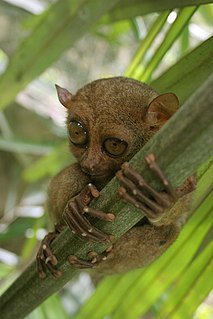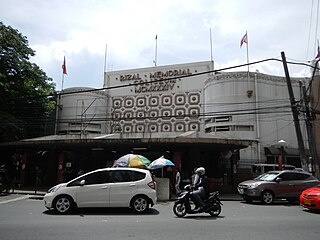
The United States Fish and Wildlife Service is an agency of the US Federal Government within the US Department of the Interior dedicated to the management of fish, wildlife, and natural habitats. The mission of the agency is "working with others to conserve, protect, and enhance fish, wildlife, plants and their habitats for the continuing benefit of the American people."

The Nature Conservancy (TNC) is a charitable environmental organization, headquartered in Arlington, Virginia, United States.

The Philippine tarsier, known locally as mawumag in Cebuano and other Visayan languages, magô in Winaray and mamag in Tagalog, is a species of tarsier endemic to the Philippines. It is found in the southeastern part of the archipelago, particularly on the islands of Bohol, Samar, Leyte and Mindanao. It is a member of the approximately 45-million-year-old family Tarsiidae, whose name is derived from its elongated "tarsus" or ankle bone. Formerly a member of the genus Tarsius, it is now listed as the only member of the genus Carlito, a new genus named after the conservationist Carlito Pizarras.

The Philippine naked-backed fruit bat or Philippine bare-backed fruit bat is a megabat that mostly lives on Negros Island. Two small populations were also found on Cebu Island in the Philippines. Like other bare-backed fruit bats, its wings meet along the midline of their bodies, making it a very agile flier. It roosted in caves, in areas where little light penetrated the gloom. It was so abundant once that it left piles of guano, which were used by miners as fertiliser.

Wildlife conservation is the practice of protecting wild plant and animal species and their habitat. Wildlife plays an important role in balancing the ecosystem and provides stability to different natural processes of nature like rainfall(transpiration from plant),changing of temperature(heat evolution by animals), fertility of soil. The goal of wildlife conservation is to ensure that nature will be around for future generations to enjoy and also to recognize the importance of wildlife and wilderness for humans and other species alike. Many nations have government agencies and NGO's dedicated to wildlife conservation, which help to implement policies designed to protect wildlife. Numerous independent non-profit organizations also promote various wildlife conservation causes.

Native plants are plants indigenous to a given area in geologic time. This includes plants that have developed, occur naturally, or existed for many years in an area.

The California Native Plant Society (CNPS) is a California environmental non-profit organization that seeks to increase understanding of California's native flora and to preserve it for future generations. The mission of CNPS is to conserve California native plants and their natural habitats, and increase understanding, appreciation, and horticultural use of native plants throughout the entire state and California Floristic Province.

The Philippine crocodile, also known as the Mindoro crocodile, the Philippine freshwater crocodile, the bukarot in Ilocano, and more generally as a buwaya in most Filipino lowland cultures, is one of two species of crocodiles found in the Philippines; the other is the larger saltwater crocodile (Crocodylus porosus). The Philippine crocodile, the species endemic only to the country, became data deficient to critically endangered in 2008 from exploitation and unsustainable fishing methods, such as dynamite fishing. Conservation methods are being taken by the Dutch/Filipino Mabuwaya foundation, the Crocodile Conservation Society and the Zoological Institute of HerpaWorld in Mindoro island. It is strictly prohibited to kill a crocodile in the country, and it is punishable by law.

The Rizal Memorial Coliseum is one of two indoor sporting arenas located inside the Rizal Memorial Sports Complex in Manila, Philippines, the other being the Ninoy Aquino Stadium. The capacity of the coliseum is 8,000.

The Washington Native Plant Society (WNPS) is a non-profit organization dedicated to the protection and appreciation of the native plants of the U.S. state of Washington. The society has participated with the state and local government agencies, as a non-governmental organization, for the protection of species, their habitats, and general environmental quality. WNPS also works in cooperation with other non-profit groups, such as the Seattle Audubon Society, for public education and advocacy in matters of mutual interest.
The New Zealand Plant Conservation Network (NZPCN) is a non-governmental organisation devoted to the protection and restoration of New Zealand's indigenous plant life, including vascular plants, mosses, liverworts, hornworts and lichens.

The flora of Scotland is an assemblage of native plant species including over 1,600 vascular plants, more than 1,500 lichens and nearly 1,000 bryophytes. The total number of vascular species is low by world standard but lichens and bryophytes are abundant and the latter form a population of global importance. Various populations of rare fern exist, although the impact of 19th-century collectors threatened the existence of several species. The flora is generally typical of the north west European part of the Palearctic ecozone and prominent features of the Scottish flora include boreal Caledonian forest, heather moorland and coastal machair. In addition to the native varieties of vascular plants there are numerous non-native introductions, now believed to make up some 43% of the species in the country.
Rafflesia baletei is a parasitic plant species of the genus Rafflesia. It is endemic to the Philippines.
Rafflesia leonardi is a parasitic plant species of the genus Rafflesia. It is endemic to the Philippines. R. leonardi is the fourth Rafflesia species found in Luzon and the eighth from the Philippines. It is called ngaratngat by the local Agta tribesmen.
Rafflesia manillana is a parasitic plant species of the genus Rafflesia. It is endemic to the Philippines.

Rafflesia schadenbergiana is a parasitic plant species of the genus Rafflesia. Known as "bó-o" to the Bagobo tribe and "kolon busaw" to the Higaonon tribe of Bukidnon, it has the largest flower among the Rafflesia species found in the Philippines with a diameter ranging from 52-80 centimeters. It has also the second largest flower in the genus after R. arnoldii.

The wildlife of the Philippines includes a significant number of endemic plant and animal species. The country's surrounding waters reportedly have the highest level of marine biodiversity in the world. The Philippines is considered as one of the seventeen megadiverse countries as well as global biodiversity hotspot. In the 2000 Red List of the International Union for the Conservation of Nature and Natural Resources (IUCN), 418 of the country's 52,177 species were listed as threatened.
The mission of Arizona Native Plant Society (AZNPS) is to promote knowledge, appreciation, conservation and restoration of Arizona native plants and their habitats, as well as the use of native plants in urban landscapes and gardens. Among its initiatives are the Plant Atlas Project of Arizona (PAPAZ), which trains AZNPS volunteers in botanical fieldwork; publication of booklets and brochures promoting the use of native plants; compilation and web publication of plant lists for various natural areas of Arizona and northern Mexico; grants for publication assistance and research; and pioneering work in invasive species education and removal.

The Association for Protection of the Environment (APE) is a non-governmental organization working on issues regarding the conservation, and restoration of the environment, education about permaculture and agroforestry among other things.
















